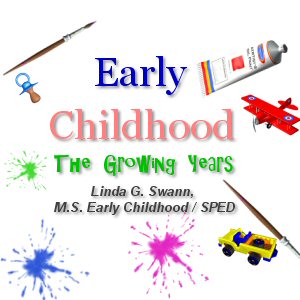Cognitive Growth Continued
 Exploring the environment is the beginning of cognitive growth with your child. At this stage, the types of toys that involve movement and sound are important. The “little gym sets” are great. These fit over the child on the floor. You can change toys that hang from the gym using “baby links”. Toys should be bright in color, or geometric in pattern (very bold and eye catching). Various textures and sounds encourage the child to focus, which in turn stimulates brain function. Toys that crinkle, bells that ring when kicked, and objects that rattle, can be interchanged to hang from the frames. Always remember safety, nothing that might go in the mouth and be swallowed (watch the eyes/noses on stuffed critters).
Exploring the environment is the beginning of cognitive growth with your child. At this stage, the types of toys that involve movement and sound are important. The “little gym sets” are great. These fit over the child on the floor. You can change toys that hang from the gym using “baby links”. Toys should be bright in color, or geometric in pattern (very bold and eye catching). Various textures and sounds encourage the child to focus, which in turn stimulates brain function. Toys that crinkle, bells that ring when kicked, and objects that rattle, can be interchanged to hang from the frames. Always remember safety, nothing that might go in the mouth and be swallowed (watch the eyes/noses on stuffed critters).
As your child grows, toys should be selected that encourage problem solving. The best toys are the ones that have more than one action. You child will be creative if the toy has multiple functions. Objects can serve as toys (remember safety). One example is “pots, pans and wooden spoons”. Add dinner spoons, metal jar tops, and a metal tea ball on a chain and be surprised at your child’s excitement. Don’t forget boxes of all sizes and shapes. Add a few balls and watch as cognitive growth happens before your eyes. Offer objects that can be put together or built (blocks, building sets, puzzles, stacking cups, etc.). When choosing a toy, be sure it is safe. Ask, “What can he/she do with the toy?” Think of at least three ways your child can play with the toy. Be sure it is colorful, has texture and holds your child’s attention. Remember, fewer batteries… more creativity.
In the the preschool years, pretend play emerges. “Play schemes” are developed. “Play schemes” are actually “little dramatic plays”, developed by the child using his/her imagination and props. Cognitive growth will explode during this time. Offer opportunities for ongoing, pretend play. Engage in these activities with your child. Pretending to cook and eat is a great way to begin. Or… pretend to play “feed the baby”. These activities are important for boys and girls. Boys can feed and take care of critters (dogs, cats, horses, etc.). This play scheme should be introduced early, and is often the first pretend play your child does. As your child gets older, the play schemes will become more expansive. Thus, offer play props (toys) that help your child expand his/her imagination. The props can be things found around the house. Put them in a box and your child’s imagination will run wild. If your child has a favorite toy, do not allow it to be the only thing he/she plays with. Put it away in the morning or afternoon, allowing for more diversity in play. Toys should never be limiting, instead they should expand the imagination which in turn, expands cognitive growth.












